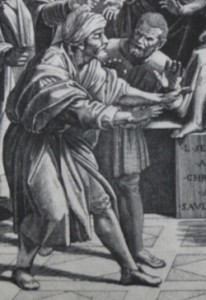A lovely book with an ugly title. I would not have taken it from the shelf had not the librarian handed it to me in lieu of Roger Fry’s study which was out. As it was, it was some time before I got round to opening it.
It is a layman’s response to Rembrandt, in the sense that Taylor is best known as a translator. He teaches at the Parsons School of design in Paris and I guess these chapters were first a most inspiring slide-lecture series to students there. I suspect he has never been subjected to a course in art history, or if he has, his sensibility has survived the blinkers, unimpared. If the book were made into a television series I guess it would do more to save Rembrandt than my rather more technical approach.
The chapter which looks at Rembrandt’s treatment of blindness is wonderful. For me, Taylor has rescued Rembrandt’s etching of “The Blind Tobit” from the doldrums and shown me a great and subtle work; (see caption below) so very different to Kenneth Clark’s treatment of the same subject.
Clark comparing Tobit to Raphael’s blind Elymas writes “Out of all the conceivable ways of representing blindness, are not the similarities of rhythm and pose almost too great for coincidence? And is not the unforgettable simplicity of Rembrandt’s Tobit – the quintessence of blindness – an indication of some deep secreted experience rather than mere observation?”
 |
|
| Taylor sees Tobit, in his excitement, has overturned the spinning wheel and, disoriented stumbles towards his own shadow rather than greet his son, Tobias, at the door. Tobias has just returned from a great adventure, his dog precedes him and is about to cause yet another mishap. | |
I am right with Clark when he talks of “deep secreted experience” but as for the rhythm and pose being similar, surely complete nonsense. Clark has an acute eye but it has been deformed by modern trends in art history: “mere observation” being a hallmark. Modern critics of art should try a bit of observation for themselves, they would soon find that it is a most demanding process requiring a life-time of vigilance.
Yes, of course Rembrandt knew Veniziano’s engraving after Raphael ( he owned a huge collection of such things) but Rembrandt’s reaction was more probably the same as mine: “child’s play; Blind-man’s-Buff, I’ll show them blindness” and then goes on to produce this little masterpiece.
Yes, artists do secrete experiences. Long forgotten memories bubble to the surface in the act of observation and it is this that activates Rembrandt’s empathetic imagination. The sooner the “experts” recognise this method the sooner we will get back on track with Rembrandt’s genius.
Taylor has a lot to say about Rembrandt’s noses but in the end it is Taylor’s nose that leads us on this enlightening, humanist tour of Rembrandt’s gifts to us.